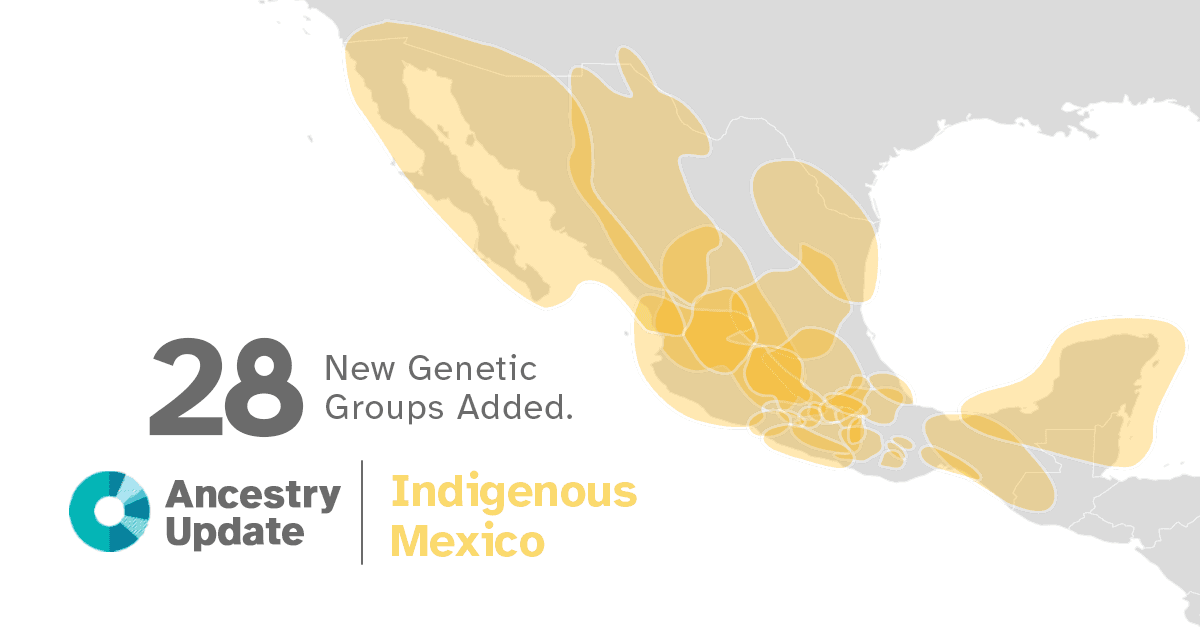23andMe has added finer detail for customers with roots that trace back to Indigenous American ancestors from 28 different regions in what is now Mexico.
The update is part of our continuing work to improve 23andMe’s Ancestry reports and features. This new update allows customers with Indigenous American ancestry from one of these Genetic Groups in Mexico to see their connections genetically as well as geographically. It also helps to convey the breadth of genetic and cultural diversity of Mexico, and the rich history of Mesoamerican civilizations there.
(Dig deeper into your ancestry with 23andMe’s DNA Ancestry service, or sign-up for a membership to unlock more about your personal genetics and geneaology.)

Indigenous populations of Mexico
Mexico, and Latin America generally, is among the world’s most ethnically diverse regions, according to UNESCO. The indigenous people within what is now Mexico have a deep history that predates European colonization by more than 15,000 thousand years. Several major indigenous cultures flourished in this precolonial period including the Olmec, Maya, and Aztec civilizations.
These indigenous groups developed innovative farming techniques and built large urban centers. The Maya were skilled astronomers and mathematicians, and developed the unique Mayan calendar. They left behind sophisticated art and architecture and massive stone pyramids. The Aztec city of Tenochtitlan, built on an island in Lake Texcoco, was at the center of a vast Aztec empire.
Another city, Teotihuacan founded 2,000 years ago, was the sixth largest urban center in the world at its zenith around the second century AD with a population of more than 120,000. The massive stone pyramids of Teotihuacan can still be seen today. Each of these cultures had their own unique art, music, and belief systems. They each had intricate trade and social hierarchies that buttressed their societies.
Spanish explorers first set foot in Mexico in 1519, and Hernan Cortes conquered the Aztecs by 1521 beginning what became 300 years of Spanish rule.
Ancestry Composition update
23andMe’s Ancestry Composition report is a living analysis that improves as we add new reference data. Underlying our Ancestry reports are powerful algorithms and analytical tools developed by 23andMe population geneticists and engineers to offer our customers more insights into their ancestral origins.
Over the last few years, we’ve updated results for people with African Ancestry, Chinese ancestry, Indigenous Caribbean Ancestry, Spanish and Portuguese Ancestry, Indigenous American ancestry, and British and Irish Ancestry, for instance.
While 23andMe customers may already see evidence of recent ancestry within Mexico, this update and these Genetic Groups represent improvements in specificity. The Genetic Groups that are part of this update are also more reflective of the distinct regional populations and customers’ ancestry.
Regions in Mexico covered in this update
Today, Mexico recognizes 68 different ethnic groups clustered into 11 linguistic families, these in turn can be divided into Northern and Southern regions of Mexico.
23andMe’s new Indigenous Mexico Genetic Groups looks at 28 groups that are also divided between Northern Mexico and Southern Mexico. Many of these Genetic Groups correspond to shared Indigenous American ancestry from parts of Mexico associated with important Indigenous agricultural innovations or specific Indigenous groups. For instance, in the Southern area, some of the Genetic Groups identified are in the Balsas River Basin, which covers an area believed to be where, 9,000 years ago, maize (corn) was first domesticated. Many of the other Genetic Groups correspond with regions once part of the Maya civilization, where Mayan languages are still spoken today. Within the Oaxaca Valley, Zapotec languages predominate, while Mixtec is common in western Oaxaca and southeastern Guerrero.
Below are the lists of Genetic Groups 23andMe has added.
The Northern Indigenous Mexican Genetic Groups are divided into nine regions:
- Northern Mexican Plateau
- Mexican Volcanic Cordillera—East Central
- Mexican Volcanic Cordillera—West
- Plains of Northeastern Mexico
- Sonoran Desert and Baja California
- West Central Mexico
- East Central Mexico
- Upper Santiago River Basin
- Mexican Volcanic Cordillera—West Central
The Southern Indigenous Mexican Genetic Groups are divided into 19 regions:
- Yucatán Peninsula
- Balsas River Basin—Central Guerrero
- Valley of Oaxaca—Ejutla
- Valley of Oaxaca—Tlacolula
- Sierra Norte of Oaxaca
- Chiapas Highlands
- Isthmus of Tehuantepec—Oaxaca
- Sierra Madre del Sur—Coast
- Balsas River Basin—Huitzuco
- Mexican Volcanic Cordillera—South Central
- Balsas River Basin—North Guerrero
- Mexican Volcanic Cordillera—Citlaltépetl and Tehuacán
- Balsas River Basin—Tierra Caliente
- Mexican Volcanic Cordillera—West Puebla
- Balsas River Basin—Southwest Puebla
- La Mixteca
- Mexican Volcanic Cordillera—Veracruz
- Balsas River Basin—West Guerrero
- La Mixteca—North
More than half a million 23andMe customers, who have tested on our latest genotyping chip, will receive a match to one or more of the Genetic Groups listed.
Among customers with four grandparents from Mexico, around 60 percent will receive a match to a Genetic Group in northern Mexico, while 30 percent will receive a match to a Genetic Group in southern Mexico.
The most common clusters in the North include the Mexican Volcanic Cordillera—West, the Upper Santiago River Basin, and the Sonoran Desert and Baja California regions. In the south the Yucatan Peninsula, Chiapas Highlands and the Balsas River Basin—West Guerrero were among the top clusters.
Find out more
23andMe customers see their Ancestry Composition.
Not yet a customer? Find out more about 23andMe’s Ancestry Service and other services.




